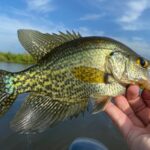Crappie is the second most popular freshwater fish in North America, bested only by the Largemouth Bass.
In fact, millions of anglers pursue crappie all year long, but many don’t understand the differences between Black Crappie vs White Crappie.
Heck, you may be reading this and wondering for yourself!
The main difference between white and black crappie are the markings on their bodies and their distribution in North America. In short, white crappie have vertical lines, whereas black crappies have irregular markings. There are also differences when it comes to anatomy (dorsal spines, body shape), and even taste.
In this article, I’ll explain the differences and similarities between the two, as well as some other important information and commonly asked questions.
By the end of this article, you should have a clear picture of the differences between both species, which makes you a more educated and prepared angler!
Table of Contents
What Is the Difference Between Black Crappie and White Crappie?
The obvious answer is, well one is black and one is white, right?
Well, no not exactly.
When it comes to species of Crappie (and all sunfish), color variability can be drastic for the same exact species of fish. Many factors influence this, including habitat, diet, and even genetics.
The easiest way to tell the difference between white crappie and black crappie is by counting the dorsal spines. White crappie have five to six dorsal spines, whereas black crappies have seven or eight.
Let’s dive deeper into additional you can tell the difference, especially out on the water.
How To Tell the Difference Between White Crappie and Black Crappie?
If you are out fishing and you catch yourself a mess of crappie, you’ll need to know what to look out for to distinguish between the two. As I mentioned, you can’t differentiate on color alone.
Dorsal spines are an easy way to differentiate between the species; however, there are a few more fundamental differences between white and black crappies:
- Markings/Patterns
- Size & Body Shape
- Distribution
Markings/Patterns
Apart from counting the dorsal spines, the easiest way to distinguish between black crappies and white crappies is by the patterns and markings.
White crappie have faint vertical lines as markings down their body, while black crappie have irregular patterns dispersed over their body.
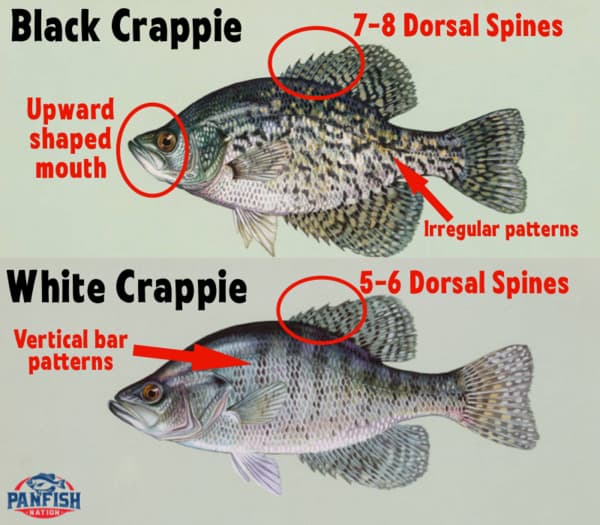
In most cases, black crappies are generally darker, although both species can be dark or light in coloration.
Size & Body Shape
One way to tell the difference between white and black crappies is by their size & body shape.
| Differences | Black Crappie | White Crappie |
|---|---|---|
| Body Shape | Compact; Rounded | Elongated; Thinner |
| Mouth Shape | Turns Upward | Larger than Black Crappie |
| Average Weight | 3/4 – 2 lbs | 1/2-1/5 lbs |
| Average Length | 8-12 inches | 9-15 inches |
Black Crappie tend to grow larger than white crappie overall. They are usually thicker and more dense than White Crappie.
Distribution
Another great way to tell the difference between crappies is their distribution, or where you catch them.
Significant overlap exists, and it’s not uncommon to catch both species of fish in the same body of water. However, there are some areas where only Black Crappie is found and vice versa.

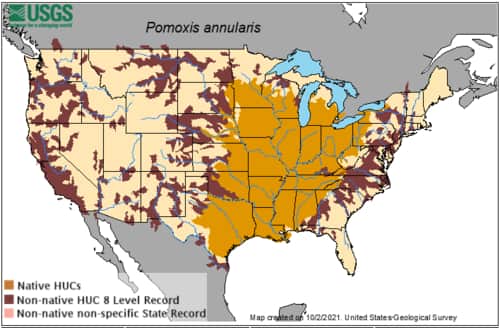
As you can see from the maps above, Black Crappie and White Crappie are found mainly in the central and eastern United States.
But take for example Florida, where I’m from. We don’t have White Crappie! I’ve fished for Crappie my entire life (or ‘specks’ as we call them here in the sunshine state) and I’ve never caught a white crappie.
Do White Crappie and Black Crappie Crossbreed?
White crappie and black crappie look similar; they both grow to about the same size and inhabit similar environments. So, it’s natural to see some interaction between both species. However, do black and white crappies crossbreed?
Black crappies and white crappies are known to crossbreed. However, once hybrid crappies reproduce themselves, their young rarely grow old enough to reach maturity.
Black and white crappies both reproduce efficiently and quickly. As a result, crappies can soon multiply, giving them an advantage over their competition. This can lead to crappies taking over their environment with ease.
Nevertheless, hybrid crappie do not reproduce effectively. They breed far slower than black or white crappies, and the generation that follows after breeding is usually unsuccessful. As a result, hybrid crappies are unable to sustain their population since the young quickly die out.
Do White Crappie and Black Crappie Taste Different?
Now that we’ve explored the differences between both crappie species when it comes to identifying them, it’s time to examine the all-important factor, taste! Do white crappie, and black crappie taste different?
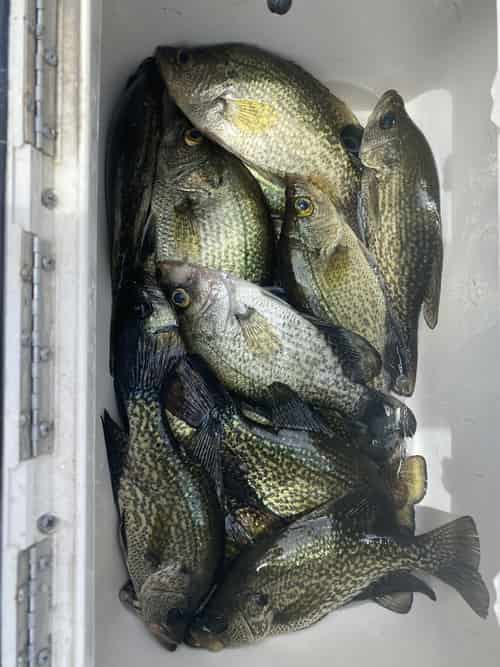
Many anglers claim that white crappie have a sweeter taste than black crappie. At the same time, black crappie offer a meatier texture due to their body shape and size. In reality, both crappie species have a very similar taste, and it is difficult to tell the difference one cooked.
The important thing is that it’s pretty unanimous among the fishing community that black crappie and white crappie are delicious and considered excellent table fare!
Hands down, it’s one of my all-time favorite fish to eat. The meat is white, flaky, delicate, and flavorful.
See Also: 3 Simple & Easy Panfish Recipes (Not Fried!)
What Are the Spawning Differences of White Crappie and Black Crappie?
White and black crappies have slight differences in appearance, anatomy, and taste, but what about spawning. Do different crappie species have different spawning behaviors and patterns?
White and black crappies generally have very similar spawning habits. The main difference between them is that black crappie usually spawn slightly earlier in the year.
A few major factors influence crappie spawning. Primarily, water temperature is the best indication of when to expect crappies to spawn—when the water temperature is close to 59° F (15 °C).
Moreover, they spawn in shallow water, usually only a few feet deep, so that light can penetrate the water and reach their eggs. Both white and crappies also prefer to breed in clearwater free from fast-moving currents.
Another way to predict if crappies in your area are about to go into spawn is by examining the colors of the fish. Both species will darken in color as water temperatures rise and they prepare to breed. This is one of the reasons why you can’t differentiate between species based on color.
Regardless of black crappie or white crappie, fishing during the spawning season is one of the best times of the year to catch crappie.
What Are the Largest White and Black Crappies Ever Caught?
Crappies continue to grow throughout their life cycle. So, they can grow significantly large if they manage to stay alive for a long time.
Here are the world record catches for both white and black crappie.
- World record black crappie catch is 5 lbs 7 oz (2.46 kg).
- World record white crappie catch is 21 in (53 cm) and 5 lbs 3 ounces (2.4 kg).
The largest black crappie ever caught was In Loudon County in Tennessee. The accomplishment belongs to Jam Ferguson, who captured the monster crappie in May 2018. This record-breaking catch was over 1lb heavier than the previous record holder.
The record catch for white crappie was set back in 1957 by Fred Bright while fishing in Mississippi. The catch has left a long-lasting record that hasn’t been matched in over 60 years.
These are extremely large specimens! Remember, the average-sized black and white crappie caught by recreational anglers is usually between 1/2-2 lbs.
My personal biggest Black Crappie is 15 inches or 1 lb 9 ounces. And I thought it was a monster!
Are There Other Species of Crappie?
Although White and Black Crappie are the main two subspecies of Crappie found in North America, there are many other regional varieties as a result of cross-breeding, hybridization, and habitat conditions.
It’s unclear if these are distinct sub-species, or simply regional terminology anglers develop. A few examples are:
- Gold Crappie
- Magnolia Crappie
- Stock Hybrid Crappie
- Natural Hybrid Crappie
- Black Nosed Crappie
Final Thoughts

I love Crappie fishing, it’s one of the main reasons I started this website. They are a really fun fish to target with jigs or live bait, they taste delicious and they are a beautiful species to admire.
So lets recap:
- White Crappie have 5-6 dorsal spines.
- Black Crappie have 7-8 dorsal spines.
- White Crappie have vertical bar patterns.
- Black Crappie have irregular patterns.
I hope you found this article helpful. Whether you fish for black crappie, white crappie or both…consider yourself lucky to pursue these amazing fish!
Best of luck and thank you for reading.
You May Also Like: What’s The Difference Between Bream and Crappie?
If you haven’t guessed yet, I love fishing and everything about it!
To learn more about why I started Panfish Nation, visit the About page and follow along on Social Media:


Download a copy of my FREE Lure Color Selection Chart & Knot Guide!
Stay up to date with fishing reports, tackle reviews, industry news, and much more! We respect your privacy, unsubscribe at any time.
- Crazy Facts About the World Record Crappie

- What Size Hooks for Smallmouth Bass? Quick Guide

- Large and in Charge-Mouth: 10 of the Best Bass Lures of All Time (And Where to Buy Them)

- Emperor of the Sun(fish): What You Need to Know About the World Record Bluegill
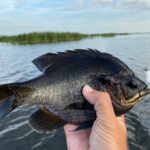
- The Seven Best Lures for Fall Bass Fishing
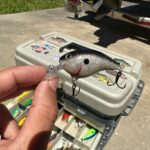
- Which Fishing Line is Best for Bass Fishing With A Spinning Reel?

- What Size Hooks for Panfish?
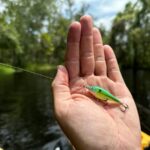
- Coppernose Bluegills: How They’re Different from Common Bluegill
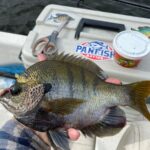
- Best Crappie Lakes In North Carolina
